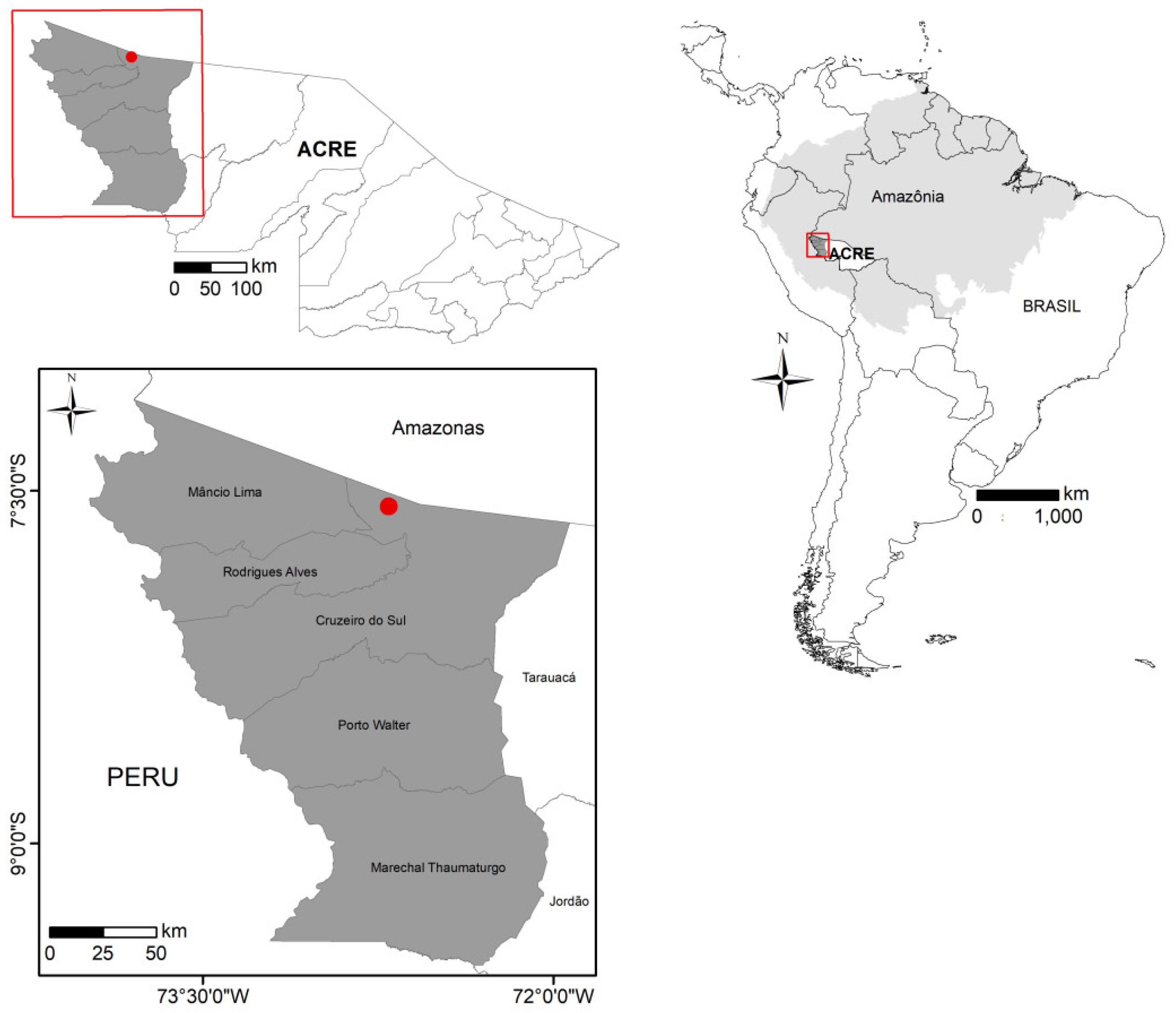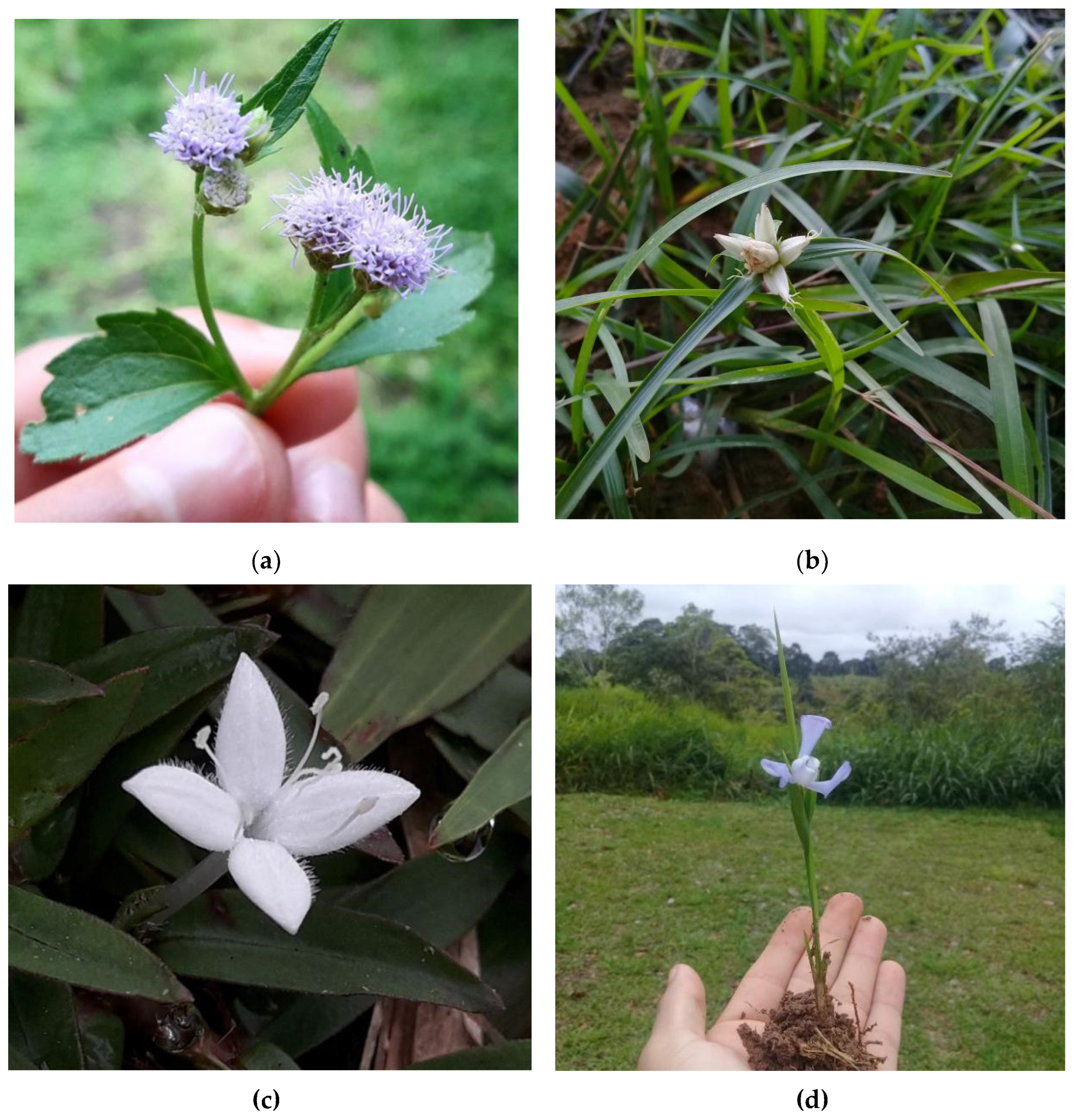Submitted:
24 June 2024
Posted:
25 June 2024
You are already at the latest version
Abstract
Keywords:
1. Introduction
2. Materials and Methods
3. Results
4. Discussion
5. Conclusions
Author Contributions
Funding
Acknowledgments
Conflicts of Interest
References
- Lorenzi, H. Plantas daninhas do Brasil: terrestres, aquáticas, parasitas e tóxicas. 4th ed. Instituto Plantarum: Nova Odessa, São Paulo, Brazil, 2008; 640p.
- Sartorelli, P.A.R.; Benedito, A.L.D.; Campos Filho, E.M.; Sampaio, A.B.; Gouveia, A.P.M.L. Guia de plantas não desejáveis na restauração florestal. Agroicone: São Paulo, Brazil, 2018; 71p.
- Araujo, E.A.; Santos, M.V.; Andrade, C.M.S., Frade Junior, E.F.; Lani, J.L.; Bardales, N.G. Plantas daninhas em pastagens do Acre: identificação e controle. SEMA: Rio Branco, Acre, Brazil, 2011; 32p.
- Daly, D.C., Silveira, M. Primeiro catálago da flora do Acre, Brasil. EDUFAC: Rio Branco, Brazil, 2008; 463p.
- Medeiros, H.; Daly, D.C.; Silveira, M.; Obermüller, F.A.; Castro, W.; Forzza, R.C. Botanical advances in Southwestern Amazonia: The flora of Acre (Brazil) five years after the first Catalogue. Phytotaxa 2014, 177(2), 101-117. [CrossRef]
- Brown Jr., K.; Freitas, A.V.L. Diversidade biológica no Alto Juruá: avaliação, causas e manutenção. In Enciclopédia da Floresta. O Alto Juruá: práticas e conhecimentos das populações. Cunha, M.C., Almeida M.B., Eds. Companhia das Letras: São Paulo, Brasil, 2002; Volume 1, pp. 33–63.
- Araújo, E.A.; Moreira, W.C.L.; Silva, J.F.; Bardales, N.G.; Amaral, E.F.; Oliveira, S.R. et al. Levantamento pedológico, aptidão agrícola e estratificação pedoambiental do Campus Floresta, Cruzeiro do Sul, Acre. Ananindeua: Itacaiunas, Brasil, 2019. p.25–75.
- Cavalcante, L.M. Geologia do estado do Acre. In Recursos naturais: geologia, geomorfologia e solos do Acre. Souza C.M., Araújo, E.A, Medeiros, M.F.S.T., Magalhães, A.A., Eds. SEMA: Rio Branco, Brazil, 2010; p.13–23.
- Delgado, R.C.; Souza L.P. Tendência da precipitação e seu aproveitamento para fins não potáveis na Amazônia Ocidental, Acre. Nativa 2014, 2(4), 208-213. [CrossRef]
- Duarte, A.F. Aspectos da climatologia do Acre, Brasil, com base no intervalo 1971 – 2000. Rev Bras Meteorol. 2006, 21(3), 308-317.
- APG IV. Angiosperm Phylogeny Group (APG). An update of the Angiosperm Phylogeny Group classification for the orders and families of flowering plants: APG IV. Bot J Linn Soc. 2016, 181(1), 1-20. [CrossRef]
- Flora do Brasil 2020 em construção. Jardim Botânico do Rio de Janeiro. Available online: http://floradobrasil.jbrj.gov.br/ (accessed on 18 May 2020).
- SpeciesLink. Sistema de Informação Distribuído para Coleções Biológicas: a integração do Species Analyst e do SinBiota (FAPESP). Available online: http://inct.splink.org.br. (Accessed on 02 march 2020).
- Rodrigues, R.S.; Perdiz, R.O.; Flores, A.S. Novas ocorrências de angiospermas para o estado de Roraima, Brasil. Rodriguésia 2017, 68(2), 783-790. [CrossRef]
- Silva, W.L.S.; Rocha, A.E.; Santos, J.U.M. Leguminosae em savanas do estuário amazônico brasileiro. Rodriguésia 2014, 65(2), 329-353.
- Coradin L.; Ramos, A.K.B. Centrosema brasilianum: Centrosema. In Espécies nativas da flora brasileira de valor econômico atual ou potencial: plantas para o futuro: Região Centro-Oeste. Vieira, R.F., Camillo, J., Coradin, L., Eds. MMA: Brasília, DF, Brazil, 2016; pp. 489–498.
- Mattar, E.P.L.; Maia, G.F.N.; Frade Junior, E.F.; Moraes, M.D.; Ortega, G.P. Desempenho de Crotalaria micans Link. em Argissollo Amarelo Distrófico no Acre Ocidental, Brasil. Rev. Bras Agroecol. 2015, 10(1), 43-49.
- François, C., Fares, M.; Baiocchi, C.; Maixent, J.M. Safety of Desmodium adscendens extract on hepatocytes and renal cells. Protective effect against oxidative stress. J. Intercult. Ethnopharmacol. 2015, 4(1), 1-5. [CrossRef]
- Chaves, O.S.; Gomes, R.A.; Tomas, A.C.A.; Fernandes M.G.; Mendes Junior L.G.; Agra M.F.; et al. Secondary metabolites from Sida rhombifolia L. (Malvaceae) and the Vasorelaxant Activity of Cryptolepinone. Molecules 2013, 18(3), 2769-2777. [CrossRef]
- Andrade C.M.S.; Dias-Filho M.B. Manejo de plantas daninhas em pastagens na Amazônia. In Recuperação de pastagens degradadas na Amazônia. Andrade, C.M.S., Dias-Filho, M.B., Eds.; EMBRAPA: Brasília, Brazil, 2019; pp. 228–230.
- Omonkhua, A.A.; Onoagbe, I.O. Evaluation of the long-term effectis of Urena lobata root extracts on bloond glucose and hepatic function of normal rabbits. J Toxicol Environ Health Sci. 2011, 3(8), 204-213.
- Koma, O.S.; Olakunle, F.A.; Theophilus, A.O. Phytochemical Screening and in Vitro Antimicrobial Activity of Waltheria indica L. Leaf Extracts. Biomed Sc. 2017, 3(5), 86-93. [CrossRef]
- Cretton, S.; Breant, L.; Pourrez, L.; Ambuehl, C.; Marcourt, L.; Ebrahimi, S.N., et al. Antitrypanosomal Quinoline Alkaloids from the Roots of Waltheria indica. J Nat Prod. 2014, 77(10), 2304-11. [CrossRef]
- Nirmala, C.; Sridevi, M. Ethnobotanical, phytochemistry, and pharmacological property of Waltheria Indica Linn. FJPS 7.1 (2021): 1-11. [CrossRef]
- Soni, K.K.; Soni, S. Eclipta alba (L.) An Ethnomedicinal Herb Plant, Traditionally Use in Ayurveda. J Hortic. 2017, 4(3), 1-2. [CrossRef]
- Almeida U.O.; Andrade Neto R.C.; Lunz A.M.P.; Tavella L.B.; Marinho T.S.; Nogueira S.R. Ocorrência de plantas daninhas em cultivo de bananeira comprida em diferentes espaçamentos no estado do Acre. SAJEBTT, 2018, 5(1), 188-203.
- Medeiros, G.R.; Rodrigues-Filho, J.L.; Matsmura-Tundisi, T.; Tundisi, J.E.M.; Abe D.S.; Oliveira, H.A. et al. Occurrence of Macrophytes species in the lower basin of the Xingu River. Braz J Biol. 2015, 75(3 suppl.), S65-S69. [CrossRef]
- Ozsoy, N.; Yilmaz, T.; Kurt, A.O.; Yanardag C.R. In vitro antioxidant activity of Amaranthus lividus L. Food Chem. 2009, 116(4), 867-872. [CrossRef]
- Fontes JRA, Tonato F. Acúmulo de nutrientes por Vassourinha-de-Botão (Spermacoce verticillata), Planta daninha de pastagens na Amazônia. Manaus: EMBRAPA; 2016, 6p. (Circular Técnica, 54).
- Peixoto Neto, P.A.S.; Silva, M.V.; Campos, N.V.C.; Porfirio, Z.; Caetano, L.C. Antibacterial activity of Borreria verticillata roots. Fitoterapia 2002, 73(6), 529-531. [CrossRef]
- Souza, M.C.; Fader, A.A.C.; Silveira, M.; Liesenfeld, M.V.A. Diodia kuntzei K. Schum (Rubiaceae, Spermacoceae): a new record for the state of Acre, Brazil. Check List 2020, 16(3), 1–5. [CrossRef]
- Santos, L.B.; Souza, J.K.; Papassoni, B.; Borges, D.G.L.; Damasceno Junior, G.A.; Souza, J.M.E.; Carollo, C.A.; Borges, F.A. Efficacy of extracts from plants of the Brazilian Pantanal against Rhipicephalus (Boophilus) microplus. Rev Bras Parasitol Vet. 2013, 22 (4), 532–538.
- Mendonça, M.S.; Souza, A.D.; Cassino, M.F.; Oliveira, A.B.; Souza, M.C.; Prata-Alonso, R.R.; Paes, L.S. Plantas medicinais usadas por Comunidades Ribeirinhos do Médio Rio Solimões, Amazonas: Identificação, etnofarmacologia e caracterização estrutural. EDUA: Manaus, Amazonas, Brazil, 2014; 77p.
- Lima, M.V.V.; Freire, A.O.; Sousa, E.L.F.; Vale, A.A.M.; Lopes, A.J.O.; Vasconcelos, C.C. et al. Therapeutic Use of Scoparia dulcis Reduces the Progression of Experimental Osteoarthritis. Molecules 2019, 24(19). [CrossRef]
- Klein, J.; Battistus, A.G.; Hoffmann, V.; Costa, N.V.; Kestring, D.; Bulegon, L.G.; Guimarães, V.F. Chemical management of Pilea microphylla in orchid seedlings. Rev Bras Herbicidas 2015, 14(1), 15-20. [CrossRef]
- Kerdudo, A.; Ellong, E.N.; Gonnot, V.; Boyer, L.; Michel, T.; Adenet, S. et al. Essential oil composition and antimicrobial activity of Hyptis atrorubens Poit. from Martinique (F.W.I.). J Essent Oil Res. 2016, 28(5), 436-444. [CrossRef]
- Tessele, P.B.; Delle-Monache, F.; Quintão, N.L.; Silva, G.F.; Rocha, L.W.; Lucena, G.M. et al. A new naphthoquinone isolated from the bulbs of Cipura paludosa and pharmacological activity of two main constituents. Planta Med. 2011, 77(10), 1035-43. [CrossRef]
- Maciel, J.R.; Silva, M.B.C. Distribuição e taxonomia de Andropogon L. (Poaceae) em Pernambuco-Brasil. Pesquisa bot. 2011, 62, 117-128.
- Souza, M.C.; Silva, O.L.M. New record of Euphorbia thymifolia L. (Euphorbiaceae) for the state of Acre, Brazil. Check List 2021, 17 (1): 137–144. [CrossRef]
- Muthumani, D.; Manickan, A.H.; Kausar, J.; Anand, V.; Pushpa. Phytopharmacological activities of Euphorbia thymifolia Linn. Syst. Rev. Pharm. 2016, 7 (1), 30–34. [CrossRef]
- Kainsa, S.; Singh, R. Flavan-3-ol Isomers Isolated from Euphorbia Thymifolia Linn. Pharmacogn. Commun. 2016, 6 (1), 28–33. [CrossRef]
- Tryon, R.M.; Stolze, R.G. Pteridophyta of Peru. Part II 15. Dennstaedtiaceae. Peru: Fieldiana Botany 1989, 22, 105-106.
- Guimarães, R.; Carvalho, G.D. Pteridium aquilinum: Importância para saúde pública. PUBVET 2014, 8(9), 0975-1135.
- Lovatto, P.B.; Mauch, C.R.; Lobo, E.A.; Schiedeck, G. Avaliação de Pteridium aquilinum (Dennstaedtiaceae) e Urtica dioica (Urticaceae) como alternativas ao equilíbrio populacional de afídeos em cultivos orgânicos no Sul do Brasil. Rev Fac Agron. 2016, 115 (2), 265-271.
- Daly, D.C.; Silveira, M.; Medeiros H.; Castro W.; Obermuller F.A. The white-sand vegetation of Acre, Brazil. Biotropica 2016, 48(1), 81–89. [CrossRef]


| Family/Species | Popular name | Collection Number | Origin | |
|---|---|---|---|---|
| Cyperaceae | Scleria gaertneri Raddi | U | CP. Silva 01 | Native |
| Rhynchospora pubera (Vahl) Boeckeler | U | CP. SILVA 17 | Native | |
| Fabaceae (Faboideae) | Centrosema brasilianum (L.) Benth | U | CP. Silva 02 | Native |
| Zornia reticulata Sm | U | CP. Silva 03 | Native | |
| Crotalaria micans Link | “crotalaria” | ASouza s/n | India | |
| Desmodium adscendens (Sw) Dc. | “carrapicho” | CP. Silva 24 | Native | |
| Asteraceae | Praxelis difusa (Rich.) Pruski | U | C.P. Silva 07 | Native |
| Emilia fosbergii Nicolson | “emilia” | C.P.Silva s/n | Native | |
| Eclipta prostrata (L.) L. | U | M.C.Souza s/n | Native | |
| Plantaginaceae | Scoparia dulcis L. | “vassourinha de botão” | C.P. Silva 10 | Native |
| Malvaceae | Sida rhombifolia L. | U | C.P. Silva 11 | Native |
| Urena lobata L. | “malva” | A.Souza 05 | Asia | |
| Waltheria indica L. | “malva“ | A.Fernandes 01 | Native | |
| Pavonia sp | U | C.P.Silva 23 | Native | |
| Poaceae | Leptochloa cf. virgata | U | C.P. Silva 12 | Native |
| Luziola cf. peruviana | U | C.P. Silva 13 | Native | |
| Andropogon bicornis L. | “rabo de burro” | Manasseis 02 | Native | |
| Paspalum cf. conspersum | U | Manasseis 03 | Native | |
| Ochnaceae | Sauvagesia erecta L. | U | A.Souza 03 | Native |
| Rubiaceae | Borreria verticillata (L.) G. Mey | “vassourinha de botão” | C.P. Silva 25 | Native |
| Diodia kuntzei K. Schum | U | M.C.Souza 781 | Native | |
| Amaranthaceae | Amaranthus blitum L. | “bredo” | M.C.Souza 766 | Native |
| Alternanthera tenella Colla | U | C.P.Silva 27 | Native | |
| Verbenaceae | Stachytarpheta cayennensis (Rich.)Vahl | “rinchão” | C.P.Silva 16 | Native |
| Urticaceae | Pilea microphylla (L.) Liebm. | U | M.C. Souza 776 | Native |
| Iridaceae | Cipura paludosa Aubl. | U | C.P.Silva 14 | Native |
| Lamiaceae | Hyptis atrorubens Poit. | U | M.C. Souza s/n | Native |
| Euphorbiaceae | Euphorbia thymifolia L. | U | M.C. Souza 793 | Native |
| Dennstaedtiaceae | Pteridium aquilinum (L.) Kuhn. | “pluma” | M.C. Souza 753 | Native |
Disclaimer/Publisher’s Note: The statements, opinions and data contained in all publications are solely those of the individual author(s) and contributor(s) and not of MDPI and/or the editor(s). MDPI and/or the editor(s) disclaim responsibility for any injury to people or property resulting from any ideas, methods, instructions or products referred to in the content. |
© 2024 by the authors. Licensee MDPI, Basel, Switzerland. This article is an open access article distributed under the terms and conditions of the Creative Commons Attribution (CC BY) license (http://creativecommons.org/licenses/by/4.0/).





